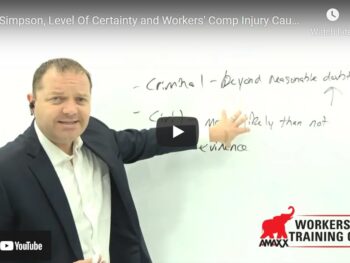
Is the Injured Party an Employee?
Workers’ compensation programs are only responsible to cover employees of an insured. In many instances, the issue of whether the injured party is an employee is clear-cut. However, in cases such as construction cases or other specialized professions such as consultants, this is an issue that requires careful legal review.
Click Link to Access Free PDF Download
“Avoid the 3 Primary Reasons Injured Workers’ Hire Attorneys”
The term “employee” is generally defined by statute or administrative rule. Basic components of what constitutes an employee include the following elements:
- A person who performs services for another for hire;
- An alien (regardless of legal status), minor, apprentice, or members of state law enforcement agencies;
- County assessors, elected or appointed officials who fulfill a function of city, county or state governments; and
- Other individuals, regardless of compensation, who fulfill the function of a company – g. – volunteers.
When it comes to “independent contractors,” a myriad of rules and case law interpretations can apply. Factors to consider include:
- The issue of “control,” and whether the employer controls the means and manner by which the work is performed;
- The method of payment to the person. Just because someone receives a W-9 does not mean they are not an employee;
- Determination as to who furnishes tools and materials used to perform a job or task; and
- The ability to discharge the worker (or whether the job ends when the work is completed).
Intoxication Defense – The Bar is Not Necessarily the Limit
Alcohol and drug use continue to be an issue when it comes to workplace safety. Use of these substances while performing work duties can result in a denial of primary liability if an injury occurs. In order to successfully assert this defense, the employer and insurer must demonstrate the following:
- The employee was intoxicated at the time of the injury; and
- The intoxication was the proximate or legal cause of the injury.
While this looks relatively simply to assert with success, the reality is courts will scrutinize these matters. Extreme examples in case law include a highly intoxicated construction worker obtaining workers’ compensation benefits after admitted he drank alcohol heavily just prior to a serve fall from height. Kowalik v. Martinson Construction, slip op. (MN WCCA 7/8/04), sum aff’d 688 N.W.2d 332 (Minn. 2004).
Prohibited Acts Defense – Is it the Right Defense?
Rules are designed to be followed and ensure workplace safety and injury prevention. It is commonly held that an employer/insurer may avoid liability for an injury under the following conditions:
- Where an employer expressly prohibits the doing of a certain specific act;
- The employee engages in the prohibited conduct in a manner of disregard, of which is not reasonably foreseeable to the employer;
- The violation takes the employee outside the scope of his employment; and
- The employee sustains an injury resulting from the prohibited conduct.
While this defense seems clear-cut, courts have generally required a high level of proof for them to be successful. Common errors on the part of an employer include failure to have the specific prohibited act written into policy and communicated to its employees, and failure of the employer to enforce its safety and/or prohibited acts policies consistently.
Conclusions
Members of the claim management team are on the front lines of matters of high importance. This includes investigation of a claim and issuing denials for illegitimate workers’ comp claims when appropriate. When making these decisions, it is important for the claim handler to scrutinize the facts of the case and correctly apply the law.

Author Michael Stack, CEO Amaxx LLC. He is an expert in workers’ compensation cost containment systems and helps employers reduce their workers’ comp costs by 20% to 50%. He works as a consultant to large and mid-market clients, is a co-author of Your Ultimate Guide To Mastering Workers Comp Costs, a comprehensive step-by-step manual of cost containment strategies based on hands-on field experience, and is founder & lead trainer of Amaxx Workers’ Comp Training Center .
Contact: mstack@reduceyourworkerscomp.com.
Workers’ Comp Roundup Blog: https://blog.reduceyourworkerscomp.com/
©2018 Amaxx LLC. All rights reserved under International Copyright Law.
Do not use this information without independent verification. All state laws vary. You should consult with your insurance broker, attorney, or qualified professional.










